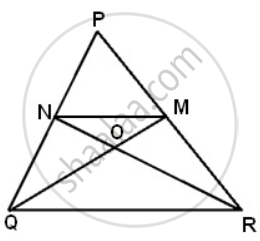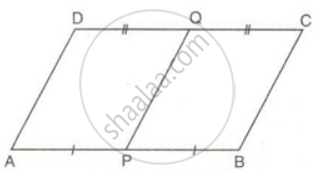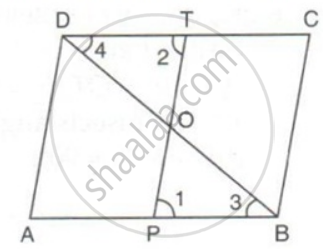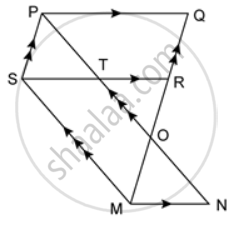Advertisements
Advertisements
प्रश्न
The medians QM and RN of ΔPQR intersect at O. Prove that: area of ΔROQ = area of quadrilateral PMON.
उत्तर

Join MN. Since the line segment joining the mid-points of two sides of a triangle is parallel to the third side; so, MN || QR
Clearly, ΔQMN and ΔRNM are on the same base MN and between the same parallel lines.
Therefore, area(ΔQMN) = area(ΔRNM)
⇒ Area(ΔQMN) - area(ΔONM) = area(ΔRNM) - area(ΔONM)
⇒ Area)ΔQON) = area (ΔROM) ......(i)
We know that a median of a triangle divides it into two triangles of equal areas.
Therefore, area(ΔQMR) = area(ΔPQM)
⇒ area(ΔROQ) + area(ΔROM) = area(quad, PMON) + area(ΔQON)
⇒ area(ΔROQ) + area(ΔROM) = area(quad. PMON) + area(ΔROM) ...(from (i))
⇒ area(ΔROQ) = area(quad. PMON).
APPEARS IN
संबंधित प्रश्न
ABCD is a parallelogram. P and Q are mid-points of AB and CD. Prove that APCQ is also a parallelogram.
ABCD is a parallelogram. P and T are points on AB and DC respectively and AP = CT. Prove that PT and BD bisect each other.
ABCD is a rectangle with ∠ADB = 55°, calculate ∠ABD.
Prove that if the diagonals of a parallelogram are equal then it is a rectangle.
Prove that the line segment joining the mid-points of the diagonals of a trapezium is parallel to each of the parallel sides, and is equal to half the difference of these sides.
In a parallelogram PQRS, M and N are the midpoints of the opposite sides PQ and RS respectively. Prove that
RN and RM trisect QS.
In a parallelogram PQRS, M and N are the midpoints of the opposite sides PQ and RS respectively. Prove that
PMRN is a parallelogram.
In the given figure, PQRS is a parallelogram in which PA = AB = Prove that: SA ‖ QB and SA = QB.
PQRS is a parallelogram and O is any point in its interior. Prove that: area(ΔPOQ) + area(ΔROS) - area(ΔQOR) + area(ΔSOP) = `(1)/(2)`area(|| gm PQRS)
In the given figure, PQ ∥ SR ∥ MN, PS ∥ QM and SM ∥ PN. Prove that: ar. (SMNT) = ar. (PQRS).
